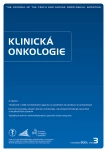A Case Report: Patient with Metastatic Goblet Cell Carcinoid
Authors:
B. Bencsiková 1; A. Jurečková 1; E. Lžičařová 2; P. Karásek 1; R. Vyzula 1
Authors‘ workplace:
Klinika komplexní onkologické péče, Masarykův onkologický ústav, Brno
1; Oddělení onkologické patologie, Masarykův onkologický ústav, Brno
2
Published in:
Klin Onkol 2013; 26(3): 208-212
Category:
Case Report
Overview
Background:
Goblet cell carcinoid represents a unique entity of appendiceal neoplasia. Its pathological features and clinical behavior are distinct from the classic carcinoid tumor as well as primary adenocarcinoma of the appendix. Correct histopathological classification and diagnosis provide guidelines for treatment and prognosis. Morphological transformation of the Goblet cell carcinoid from typical Goblet cell carcinoid to adenocarcinoma morphology is likely associated with accumulation of additional genetic changes that is why subclassification of this group of tumors is needed. Investigation of molecular genetic changes could increase our understanding of this exotic but clinically important group of tumors.
Case:
We present the case of a patient with metastatic goblet cell carcinoid involving terminal ileum, ascendent colon, ovary, omentum and peritoneal spreading, treated with debulking surgery and chemotherapy (FOLFOX4 regimen) with good response, reduction of disease on CT and PET complete remission. Improvement of clinical symptoms as well as quality of life was reached by combined palliative treatment.
Conclusion:
Correct diagnostics and therapeutic efforts bring patient benefit even in metastatic setting. Better knowledge of rare tumors and understanding of their biology help improve therapeutic approaches.
Key words:
goblet cell carcinoid – appendiceal neoplasm – chemotherapy
Sources
1. McGory ML, Maggard MA, Kang H et al. Malignancies of the appendix: beyond case series reports. Dis Colon Rectum 2005; 48(12): 2264 – 2271.
2. McCusker ME, Coté TR, Clegg LX et al. Primary malignant neoplasms of the appendix: a population‑based study from the surveillance, epidemiology and end‑results program, 1973 – 1998. Cancer 2002; 94(12): 307 – 3312.
3. Landry CS, Woodall C, Scoggins et al. Analysis of 900 appendiceal carcinoid tumors for a proposed predictive staging system. Arch Surg 2008; 143(7): 664 – 670.
4. Tang LH, Shia J, Soslow RA et al. Pathologic classification and clinical behavior of the spectrum of goblet cell carcinoid tumors of the appendix. Am J Surg Pathol 2008; 32(10): 1429 – 1443.
5. Tönnies H, Toliat MR, Ramel C et al. Analysis of sporadic neuroendocrine tumours of the enteropancreatic system by komparative genomic hybridisation. Gut 2001; 48(4): 536 – 541.
6. Mandai M, Konishi I, Tsuruta Y et al. Krukenberg tumor from an occult appendiceal adenocarcinoid: a case report and review of the literature. Eur J Obstet Gynecol Reprod Biol 2001; 97(1): 90 – 95.
7. Hristov AC, Young RH, Vang R et al. Ovaria metastases of appendiceal tumors with goblet cell carcinoid‑like and signet ring cell patterns: a report of 30 cases. Am J Surg Pathol 2007; 31(10): 1502 – 1511.
8. Modlin IM, Öberg K. A Century of Advances in Neuroendocrine Tumor Biology and Treatment. Felsenstein C. C. C. P. 2007; 116 – 123.
9. Bergestuen DS, Aabakken L, Holm K et al. Small intestinal neuroendocrine tumors: prognostic factors and survival. Scand J Gastroenterol 2009; 44(9): 1084 – 1091.
10. Pham TH, Wolff B, Abraham SC et al. Surgical and chemotherapy treatment outcomes of goblet cell carcinoid: a tertiary cancer center experience. Ann Surg Oncol 2006; 13(3): 370 – 376.
11. Pahlavan PS, Kanthan R. Goblet cell carcinoid of the appendix. World J Surg Oncol 2005; 3(36): 157.
12. Garin L, Corbinais S, Boucher E et al. Adenocarcinoid of the appendix vermiformis complete and persistent remission after chemotherapy (FOLFOX) of a metastatic case. Dig Dis Sci 2002; 47 : 2760 – 2762.
13. Pape UF, Perren A, Niederle B et al. ENETS Consensus Guidelines for the management of patients with neuroendocrine neoplasms from the jejuno ‑ ileum and the appendix including goblet cell carcinomas. Neuroendocrinology 2012; 95(2): 135 – 156.
14. Roy P, Chetty R. Goblet cell carcinoid tumors of the appendix: An Overview. World J Gastrointest Oncol 2010; 2(6): 251 – 258.
Labels
Paediatric clinical oncology Surgery Clinical oncologyArticle was published in
Clinical Oncology

2013 Issue 3
- Metamizole vs. Tramadol in Postoperative Analgesia
- Current Insights into the Antispasmodic and Analgesic Effects of Metamizole on the Gastrointestinal Tract
- Spasmolytic Effect of Metamizole
- Metamizole in the Treatment of Acute Postoperative Pain
- Metamizole at a Glance and in Practice – Effective Non-Opioid Analgesic for All Ages
Most read in this issue
- Prostate Carcinoma. Current Dilemma of Urooncology. How to Help the Needed and not to Harm the Others
- Results of Curative Chemoradiotherapy in Patients with Carcinomas of the Anus
- Communication as a Part of the Supportive Treatment in Cancer Care
- Lenalidomide Maintenance Therapy in Patients with Multiple Myeloma
